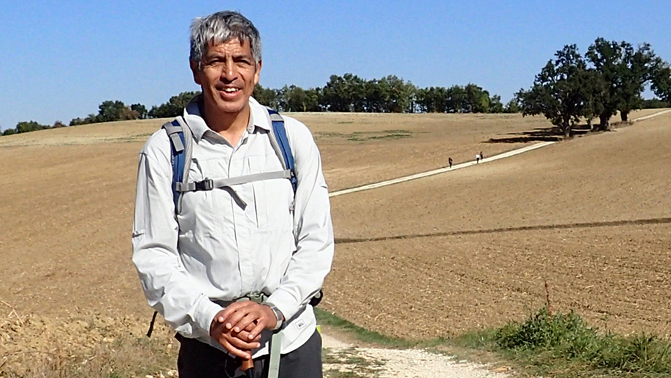Ray Rivera recalls boasting to friends about his heart health. During a span of four years, he’d walked more than 1,500 miles along the famous Camino de Santiago, the ancient pilgrimage trails throughout Spain, Portugal and France.
Then during a routine checkup in 2015, Rivera was diagnosed with atrial fibrillation, or an irregular heartbeat. Within a few months, doctors also identified a leaky heart valve and an aneurysm. Surgery in 2016 to replace the valve and perform an ablation to correct the AFib also revealed two clogged arteries requiring a bypass.
The diagnoses hit Rivera, then 61, hard. He was active, maintained a healthy weight and didn’t have high blood pressure or high cholesterol. Although his brother had undergone bypass surgery a few years earlier, Rivera hadn’t realized that family history could mean he was at risk for heart disease, or that age increased the risk for AFib.
Ray Rivera during a 200-mile walk in France in 2016, about six months after his heart surgery. (Photo courtesy of Ray Rivera)
“I was going around telling everyone how strong my heart was,” said Rivera, who lives in Pasadena, California. “I just assumed I was fit and heart-healthy.”
Rivera’s experience isn’t unusual, said Dallas-area cardiologist John Osborne, M.D., Ph.D., who specializes in treating AFib at State of the Heart Cardiology.
“Many AFib patients don’t have symptoms, so it’s important, particularly as you get older, to get checked,” Osborne said.
September is National AFib Awareness Month. The condition affects more than 2.7 million Americans and occurs when electrical signals in the upper chambers of the heart become chaotic, disrupting the regular rhythm of the heart and its ability to efficiently move blood through its chambers. Left untreated, AFib may increase the risk for stroke by five times and doubles the chance of heart-related death.
“Treatments now are dramatically better than even a few years ago and most AFib patients can lead a normal life,” Osborne said.
The risk of developing AFib increases with age, affecting about 9 percent of people over age 65. Other risk factors include uncontrolled high blood pressure, underlying heart disease, family history, obesity and sleep apnea. Excessive alcohol consumption, smoking and prolonged athletic training can also increase AFib risk.
Like many AFib patients, Rivera never noticed any symptoms, which can include a fluttering heartbeat, heart palpitations, lightheadedness or feeling winded even while at rest. Less common symptoms include chest pain or fainting.
Medications such as anticoagulants, or blood thinners, are used to reduce the risk of stroke in people with AFib. But experts say a class of newer medications called direct-acting oral anticoagulants may be safer and more convenient because they do not require as much blood monitoring, have fewer drug interactions and no food interactions.
For example, the efficacy of warfarin can be affected by changes in Vitamin K, which is prevalent in green leafy vegetables. Concerns over potential interaction left many patients avoiding heart-healthy vegetables, said Osborne.
“DOACs are the greatest advance in anticoagulation in the last 60 years,” he said. “Especially for someone who travels, they really make life easier.”
Rivera set a goal to return to pilgrimage walks following surgery and pushed himself to walk farther each day. While he generally tried to maintain a well-balanced diet, Rivera added more fruits and vegetables and reduced his alcohol consumption. He also built a strong support system to help him maintain a positive outlook as he weathered the ups and downs of recovery, both physical and mental.
Six months after surgery, Rivera embarked on a 200-mile walk along a trail in France and completed a second walk six months later.
“I was worried I’d never be the same, but once I realized I could do it, I wanted to get back out there as soon as possible,” he said.
Rivera takes a direct-acting oral anticoagulant and wears a medical bracelet with information about his condition and alerts his walking companions about where to locate medical details in the event of an emergency. That’s an important precaution, Osborne said, because while the newer anticoagulants have fewer risks, the main side effect is bleeding.
“If a patient is unconscious, it’s important for medical providers to know if he or she is on an anticoagulant,” Osborne said.
Now 63, Rivera encourages others to recognize their risks for heart disease and talk with their medical provider, even if they think they’re healthy.
“People assume because they have no symptoms, they’re okay, but I’m a perfect example of someone who had a bad heart and no symptoms,” Rivera said.
